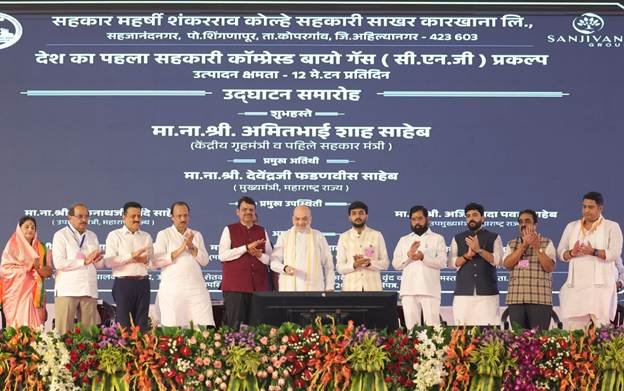Wednesday, 12 November 2025

Sets template for 100 per cent circular economy in sugar sector; 15 more mills to follow under NCDC support
Union Home Minister and Minister of Cooperation Amit Shah on Sunday inaugurated India’s first cooperative multi-feed Compressed Biogas (CBG) plant at the Maharshi Shankarrao Kolhe Sahakari Sakhar Karkhana in Kopargaon, Ahilyanagar district, Maharashtra. The landmark project marks a major leap toward establishing a circular economy model in India’s cooperative sugar industry.
The plant, built at a cost of around Rs 55 crore, will produce 12 tonnes of CBG and 75 tonnes of Potash granules daily from sugarcane byproducts such as jaggery and molasses. Both products are currently imported, and the initiative is expected to significantly reduce import dependence while creating new income streams for sugar cooperatives.
Calling the initiative “a milestone in India’s cooperative movement,” Amit Shah said the Maharshi Shankarrao Kolhe cooperative had set a benchmark for sustainability and innovation. “Cooperative sugar factories were born in Maharashtra, and it is only fitting that the journey toward a 100 per cent circular economy for sugar mills begins here,” Shah said.
Under a new initiative, the Modi government will extend full support to 15 cooperative sugar mills to set up similar CBG and potash units with financial assistance from the National Cooperative Development Corporation (NCDC). “This marks a new era for India’s sugar industry, transforming waste into wealth and creating local energy independence,” Shah added. He also urged sugar mills to diversify into fruit processing and ethanol production, noting that “integrated value addition is key to increasing farmer profitability and ensuring long-term viability for cooperatives.”
Reaffirming the Centre’s commitment to farmer welfare, Shah outlined recent decisions approved by the Union Cabinet led by Prime Minister Narendra Modi. The Mission for Aatmanirbharta in Pulses, with an outlay of Rs 11,340 crore, aims to make India self-reliant in the pulses sector by establishing 1,000 processing units, distributing 38 lakh seed kits, and ensuring 100 per cent MSP procurement of arhar, urad, and masoor through NAFED and NCCF, benefiting nearly 20 million farmers. The Cabinet has also approved hikes in the Minimum Support Price (MSP) of key crops — Rs 300 per quintal for masoor, Rs 250 for mustard, Rs 225 for gram, Rs 175 for barley, and Rs 160 for wheat.
Over the past decade, MSP for jowar, bajra, tur, moong, soybean, and cotton has more than doubled, reflecting the government’s focus on income security for cultivators. In addition, the Goods and Services Tax (GST) on critical agricultural inputs has been reduced to 5 per cent across categories including tractors, harvesters, drip and sprinkler irrigation systems, and machinery for poultry and beekeeping, along with organic pesticides and natural menthol. The tax relief is expected to reduce the cost of operations for millions of farmers across India.
The Sanjeevani Group, which manages the Kopargaon sugar mill, has expanded its cooperative model across multiple sectors. It has integrated 100 Primary Agricultural Credit Societies (PACS), promoted fisheries for 1,000 farmers, launched Sanjeevani University for 20,000 rural students, and established India’s first rural call centre, creating employment opportunities and empowering self-help groups in Maharashtra’s sugar belt.
Shah said the establishment of the Ministry of Cooperation has given new life to India’s cooperative ecosystem. “The uncertainties around the cooperative model have ended. Today, cooperatives are emerging as the third pillar of India’s economic structure,” he said. He credited Prime Minister Modi’s leadership for elevating India’s economy from 11th to 4th position globally, stressing that the next leap to the top would depend on swadeshi-led growth and self-reliant production.
Reiterating the Prime Minister’s climate appeal, Shah urged citizens to plant one tree in the name of their mother and one for Mother Earth, calling it a collective step toward combating climate change and global warming. He concluded by emphasizing that the Kopargaon project should serve as a replicable model across India’s sugar belt, combining renewable energy, cooperative entrepreneurship, and local innovation to redefine the future of India’s rural economy.